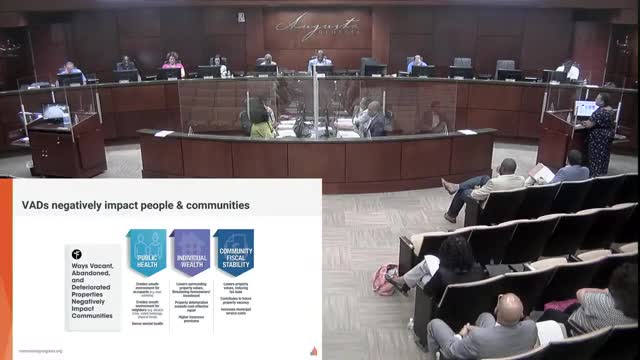Communities fight back against vacant property crisis
August 09, 2024 | Augusta City, Richmond County, Georgia
This article was created by AI summarizing key points discussed. AI makes mistakes, so for full details and context, please refer to the video of the full meeting. Please report any errors so we can fix them. Report an error »

During a recent government meeting, officials addressed the pressing issue of vacant and abandoned properties, highlighting their detrimental effects on communities. The discussions underscored the psychological toll on residents who have lived near these properties for generations, as well as the financial implications for homeowners. Properties in proximity to vacancies often see a decline in individual equity, which can hinder families from passing wealth to future generations.
The meeting also noted that the deterioration of these properties can lead to repair costs that exceed their value, further exacerbating the financial strain on homeowners. As property values decrease, communities face a shared fiscal burden, including a reduced tax base while still incurring expenses for code enforcement and maintenance of these neglected sites.
To combat these challenges, the concept of land banks was introduced. A land bank is defined as a public authority or nonprofit organization that focuses on converting vacant, abandoned, and delinquent properties into assets that promote equitable community development. The Center for Community Progress, which supports the National Land Bank Network, reported that there are over 300 land banks operating across the United States, with more than 80% established since 2000. States such as Michigan, Ohio, New York, Pennsylvania, and Georgia have the highest concentrations of these land banks, which operate under state enabling legislation.
The meeting emphasized the importance of land banks as a strategic tool for revitalizing communities and addressing the ongoing cycle of vacancy and decline.
The meeting also noted that the deterioration of these properties can lead to repair costs that exceed their value, further exacerbating the financial strain on homeowners. As property values decrease, communities face a shared fiscal burden, including a reduced tax base while still incurring expenses for code enforcement and maintenance of these neglected sites.
To combat these challenges, the concept of land banks was introduced. A land bank is defined as a public authority or nonprofit organization that focuses on converting vacant, abandoned, and delinquent properties into assets that promote equitable community development. The Center for Community Progress, which supports the National Land Bank Network, reported that there are over 300 land banks operating across the United States, with more than 80% established since 2000. States such as Michigan, Ohio, New York, Pennsylvania, and Georgia have the highest concentrations of these land banks, which operate under state enabling legislation.
The meeting emphasized the importance of land banks as a strategic tool for revitalizing communities and addressing the ongoing cycle of vacancy and decline.
View full meeting
This article is based on a recent meeting—watch the full video and explore the complete transcript for deeper insights into the discussion.
View full meeting
